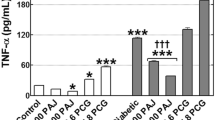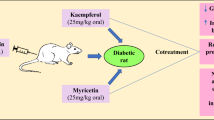Abstract
The prevalence of diabetes mellitus is becoming more and more serious and reaches epidemic proportions worldwide. Scientific research is constantly looking for new agents that could be used as dietary functional ingredients in the fight against diabetes. The objective of the present study was to evaluate the effect of ethyl acetate fraction of Hibiscus rosa sinensis Linn. petals on experimental diabetes at a dose of 25 mg/kg body weight and it was compared with standard anti-diabetic drug metformin. The elevated levels of serum glucose (398.56 ± 35.78) and glycated haemoglobin (12.89 ± 1.89) in diabetic rats were significantly decreased (156.89 ± 14.45 and 6.12 ± 0.49, respectively) by Hibiscus rosa sinensis petals (EHRS) administration. Hepatotoxicity marker enzyme levels in serum were normalized. The fraction supplementation restored the glycogen content by regulating the activities of glycogen metabolizing enzymes. It significantly modulated the expressions of marker genes involved in glucose homeostasis signalling pathway. Histopathological analysis of liver and pancreas supported our findings. The overall effect was comparable with metformin. Hence, our study reveals the role of hibiscus petals for alleviation of diabetes complications, thus it can be propagated as a nutraceutical agent.





Similar content being viewed by others
References
Robertson RP (2004) Chronic oxidative stress as a central mechanism for glucose toxicity in pancreatic islet beta cells in diabetes. J Biol Chem 279:42351–42354
Ishii H, Jirousek MR, Koya D, Takagi C, Xia P, Clermont A (1996) Amelioration of vascular dysfunctions in diabetic rats by an oral PKCb inhibitor. Science 272:728–731
Bogardus C, Lillioja S, Stone K, Mott D (1984) Correlation between muscle glycogen synthase activity and in vivo insulin action in man. J Clin Invest 73:1185–1190
Cline GW, Petersen KF, Krssak M, Shen J, Hundal RS, Trajanoski Z, Shulman GI (1999) Impaired glucose transport as a cause of decreased insulin-stimulated muscle glycogen synthesis in type 2 diabetes. N Engl J Med 341:240–246
Hofteizer B, Carpenter AM (1973) Comparison of STZ induced diabetes in rats, including volumetric quantization of pancreatic islet cells. Diabetologia 9:178–184
Soman S, Rauf AA, Indira M, Rajamanickam C (2010) Antioxidant and antiglycative potential of ethyl acetate fraction of Psidium guajava leaf extract in streptozotocin-induced diabetic rats. Plant Foods Hum Nutr 65:386–391
Naowaboot J, Pannangpetch P, Kukongviriyapan V, Kongyingyoes B, Kukongviriyapan U (2009) Antihyperglycemic, antioxidant and antiglycation activities of mulberry leaf extract in streptozotocin-induced chronic diabetic rats. Plant Foods Hum Nutr 64:116–121
Jadhav VM, Thorat RM, Kadam VJ, Sathe NS (2009) Hibiscus rosa sinensis Linn –“Rudrapushpa”: a review. J Pharm Res 2:1168–1173
Chopra RN, Nayar SL, Chopra IC (1956) Glossary of Indian medicinal plants, National Institute of Science Communication, New Delhi
Facciola S (1998) Cornucopia II: a source book of edible plants. Kampong Publications, Vista
Ali MS, Azhar I (2000) Treatment by natural drugs. Hamdard Medicus 43(2):72–78
Büyükbalci A, El SN (2008) Determination of in vitro anti-diabetic effects, antioxidant activities and phenol contents of some herbal teas. Plant Foods Hum Nutr 63:27–33
Sneha SP, Mini S (2014) In vitro antioxidant activities of different solvent fractions from the ethanolic extract of Hibiscus rosa sinensis petals. Int J Pharm Sci Res 5:3879–3885. doi:10.13040/IJPSR.0975-8232.5(9).3879-85
Huggett ASG, Nixon DA (1957) Use of glucose oxidase, peroxidase, and O-dianisidine in determination of blood and urinary glucose. Lancet 270:368–370
Reitman S, Frankel SA (1957) Colorimetric method for tile determination of serum glutamic oxalacetic and glutamic pyruvic transaminases. Am J Clin Pathol 28:56
Carroll NV, Longley RW, Roe JH (1956) The determination of glycogen in liver and muscle by use of anthrone reagent. J Biol Chem 220:583–593
Najjar V (1955) Phosphoglucomutase from muscle. In: Colowick S, Kaplan O (eds) Methods in enzymology vol. 1. Academic Press, New York, p. 294
Sutherland EW (1955) Polysaccharide phosphorylase, liver. Methods Enzymol. 1:215–222
Chomczynski P, Sacchi N (1987) Singlet-step method of RNA isolation by acid guanidium thiocyanate–phenol–chloroform extraction. Anal Biochem 162:156–159
Disbrey BD, Rack JH (1970) Book of histological laboratory methods. Harcourt Brace/Churchill Livingstone, pp. 379–396
Bennet CA, Franklin NI (1967) Statistical analysis in chemistry and the chemical industry. Wiley, New York, pp. 208–227
Fitzenberger E, Deusing DJ, Wittkop A, Kler A, Kriesl E, Bonnländer B, Wenzel U (2014) Effects of plant extracts on the reversal of glucose-induced impairment of stress-resistance in Caenorhabditis elegans. Plant Foods Hum Nutr 69:78–84
Koenig RJ, Peterson CM, Kilo C, Cerami A, Williamson JR (1976) Hemoglobin Alc as an indicator of the degree of glucose intolerance in diabetes. Diabetes 25:230–232
Sachdewa A, Khemani LD (2003) Effect of Hibiscus rosa sinensis Linn. ethanol flower extract on blood glucose and lipid profile in streptozotocin induced diabetes in rats. J Ethnopharmacol 89:61–66
Elizabeth H, Harris MD (2005) Elevated liver function tests in type 2 diabetes. Clin Diabetes 23:115–119
Navarro CM, Montilla PM, Martin A (1993) Free radicals scavenger and antihepatotoxic activity of Rosmarinus. Planta Med 59:312–314
Hornbrook KR (1970) Synthesis of liver glycogen in starved alloxan diabetic rats. Diabetes 19:916–923
Greenberg CC, Jurczak MJ, Danos AM, Brady MJ (2006) Glycogen branches out: new perspectives on the role of glycogen metabolism in the integration of metabolic pathways. Am J Physiol Endocrinol Metab 291:E1–E8
Vollenweider P (2003) Insulin resistant states and insulin signaling. Clin Chem Lab Med 41:1107–1119
Grimes CA, Jope RS (2001) The multifaceted roles of glycogen synthase kinase 3beta in cellular signaling. Prog Neurobiol 65:391–426
Karlsson HK, Ahlsén M, Zierath JR, Wallberg-Henriksson H, Koistinen HA (2006) Insulin signaling and glucose transport in skeletal muscle from first-degree relatives of type 2 diabetic patients. Diabetes 55:1283–1288
Sneha SP, Sugathan K, Indira M (2012) Selenium down regulates RAGE and NFκB expression in diabetic rats. Biol Trace Elem Res 149:71–77
Acknowledgements
The financial assistance from DST/INSPIRE, New Delhi, India and the facilities provided by University of Kerala are greatly acknowledged.
Author information
Authors and Affiliations
Corresponding author
Ethics declarations
Conflicts of Interest
The authors declare that they have no conflict of interest.
Rights and permissions
About this article
Cite this article
Pillai, S.S., Mini, S... Hibiscus rosa sinensis Linn. Petals Modulates Glycogen Metabolism and Glucose Homeostasis Signalling Pathway in Streptozotocin-Induced Experimental Diabetes. Plant Foods Hum Nutr 71, 42–48 (2016). https://doi.org/10.1007/s11130-015-0521-6
Published:
Issue Date:
DOI: https://doi.org/10.1007/s11130-015-0521-6




